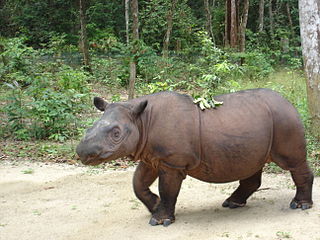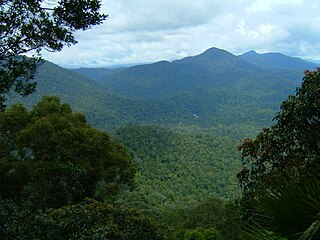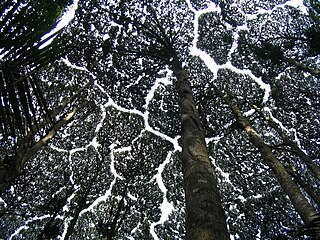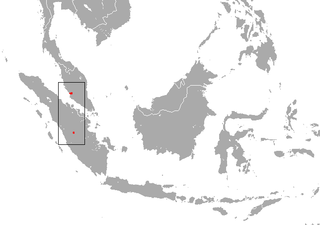
The Sumatran rhinoceros, also known as the hairy rhinoceros or Asian two-horned rhinoceros, is a rare member of the family Rhinocerotidae and one of five extant species of rhinoceros. It is the only extant species of the genus Dicerorhinus. It is the smallest rhinoceros, although it is still a large mammal; it stands 112–145 cm (3.67–4.76 ft) high at the shoulder, with a head-and-body length of 2.36–3.18 m (7.7–10.4 ft) and a tail of 35–70 cm (14–28 in). The weight is reported to range from 500 to 1,000 kg, averaging 700–800 kg (1,540–1,760 lb), although there is a single record of a 2,000 kg (4,410 lb) specimen. Like both African species, it has two horns; the larger is the nasal horn, typically 15–25 cm (5.9–9.8 in), while the other horn is typically a stub. A coat of reddish-brown hair covers most of the Sumatran rhino's body.

The Malayan tiger is a tiger from a specific population of the Panthera tigris tigris subspecies that is native to Peninsular Malaysia. This population inhabits the southern and central parts of the Malay Peninsula and has been classified as critically endangered on the IUCN Red List in 2015. The population was estimated at 250 to 340 adult individuals in 2013 and likely comprises less than 200 mature breeding individuals and has a declining trend.

Malaysia is a country in Southeast Asia. The federal constitutional monarchy consists of thirteen states and three federal territories, separated by the South China Sea into two regions, Peninsular Malaysia and Borneo's East Malaysia. Peninsular Malaysia shares a land and maritime border with Thailand and maritime borders with Singapore, Vietnam, and Indonesia. East Malaysia shares land and maritime borders with Brunei and Indonesia and a maritime border with the Philippines and Vietnam. Kuala Lumpur is the national capital and largest city while Putrajaya is the seat of the federal government. With a population of over 32 million, Malaysia is the world's 43rd-most populous country. The southernmost point of continental Eurasia is in Tanjung Piai. In the tropics, Malaysia is one of 17 megadiverse countries, home to a number of endemic species.

Endau-Rompin National Park is a protected tropical rainforest in the southernmost prolongation of the Tenasserim Hills, Malaysia. It is south of the state of Pahang and northeast of Johor covering an area of approximately 870 km2 (340 sq mi), making it the second-largest national park in Peninsular Malaysia after Taman Negara. It has approximately 26 km (16 mi) of trail. It is the second national park proclaimed by the government of Malaysia. Gunung Besar, the second-highest peak in Johor, is in the park.
Cotylelobium melanoxylon is a tropical rainforest tree found in Maritime Southeast Asia. The name melanoxylon is derived from Greek and describes the dark heartwood. It is a very good quality timber, as it has very hard and heavy as well as durable wood. C. melanoxylon is a tall emergent tree, up to 60 m, found in mixed dipterocarp forest on yellow sandy soils. It also occurs as a smaller canopy tree in kerangas forest on podsols. The tree occurs in at least three protected areas. Local names of the tree include Resak tembaga in Malay and Khiam (เคี่ยม) in Thai. The tree is the provincial symbol tree of Surat Thani Province, Thailand.

Bukit Larut is a hill resort in Malaysia located in the state of Perak, Malaysia, 10 kilometres southwest from Taiping. It was established under the direction of British colonists in 1884 as a place of observation for tin mining activity and as a retreat for the English people who were based in nearby Larut and Taiping. The area was initially named Maxwell Hill after the British Malaya administrator George Maxwell, and was renamed as Bukit Larut in 1979.

The Malayan civet, also known as the Malay civet and Oriental civet, is a viverrid native to the Malay Peninsula and the islands of Sumatra, Bangka, Borneo, the Riau Archipelago, and the Philippines. It is listed as "Least Concern" by IUCN as it is a relatively widely distributed, appears to be tolerant of degraded habitats, and occurs in a number of protected areas.

Anisoptera costata is an endangered species of plant in the family Dipterocarpaceae. The name costata is derived from Latin and describes the prominent venation of the leaf blade. A huge emergent tree up to 65 m high, it is found in evergreen and semi-evergreen lowland tropical seasonal forests of Indo-Burma and in mixed dipterocarp forests of Malesia.
Shorea dealbata is a species of plant in the family Dipterocarpaceae. The species name is derived from Latin and refers to the pale undersurface of the leaf.
Cotylelobium burckii is a species of plant in the family Dipterocarpaceae. The species is named after W. Burck, (1848–1910), a botanist that worked on the Dipterocarpaceae and the Sapotaceae. C. burckii is a canopy tree, up to 40 m, found in kerangas forests on deep white sand podsols. The species is endemic to Borneo. It is found in at least two protected areas.
Cotylelobium lanceolatum is a species of plant in the family Dipterocarpaceae. The name is derived from Latin and refers to the shape of the leaf blade. C. lanceolatum is a canopy tree, up to 45 m, found in kerangas forests on raised beach terraces and sandstone plateaux and on organic soils over limestone. The species is found in Peninsular Thailand, eastern coastal areas of Peninsular Malaysia, the Anambas Islands and Borneo. It is found in at least two protected areas.

Dryobalanops aromatica, commonly known as Borneo camphor, camphor tree, Malay camphor, or Sumatran camphor, is a species of critically endangered plant in the family Dipterocarpaceae. The species name aromatica is derived from Latin and refers to the smell of the dammar (resin). This species was one of the main sources of camphor and attracted early Arab traders to Borneo, at that time being worth more than gold, and used for incense and perfumes.
Dryobalanops beccarii, or Kapur Keladan, is a species of plant in the family Dipterocarpaceae. The species is named after Odoardo Beccari, 1843–1920, an Italian explorer and botanist. It is found in Peninsular Malaysia and Borneo. It is a large emergent tree, up to 65 m tall, found in mixed dipterocarp forests on shallow leached soils over both sandstone and shale. It is a heavy hardwood sold under the trade names of Kapur. It is recorded from at least four protected areas.

Dipterocarpus caudatus is a species of plant in the evergreen or semi-evergreen family Dipterocarpaceae. The species name is derived from Latin and refers to the narrow acumen of the leaf apex. It is an emergent tree, up to 50 m tall, in mixed dipterocarp forest on dry ridges. It is found within Sumatra, coastal Peninsular Malaysia, Singapore and Borneo. It is a medium hardwood sold under the trade names of Keruing. It was formerly most abundant along the coastal hills on sandy soils, but is endangered due to land conversion. D. caudatus is found in at least one protected area.

The environment of Malaysia is the biotas and geologies that constitute the natural environment of Malaysia. Malaysia's ecology is megadiverse, with a biodiverse range of flora and fauna found in various ecoregions throughout the country. Tropical rainforests encompass between 59% to 70% of Malaysia's total land area, of which 11.6% is pristine. Malaysia has the world's fifth largest mangrove area, which totals over a half a million hectares.

The orbiculus leaf-nosed bat, also known as the orbiculus roundleaf bat and small disc roundleaf bat, is a species of bat from the family Hipposideridae. The species has been found on the island of Sumatra in Indonesia and on peninsular Malaysia.
Helicia attenuata is a plant in the family Proteaceae. The specific epithet attenuata means "drawn out", referring to the leaf base.
Helicia petiolaris is a plant in the family Proteaceae. The specific epithet petiolaris means "stalked", referring to the leaves.
Heliciopsis velutina is a species of trees, in the family Proteaceae. They grow up to 25 metres (80 ft) tall, with a trunk diameter of up to 25 cm (10 in). The bark is dark brown. They have reddish brown flowers. They have brown, ellipsoid fruits up to 4 cm (2 in) long. The specific epithet velutina comes from the Latin meaning "velvety", referring to the petiole. They grow naturally in lowland mixed dipterocarp forests' habitats from sea level to 600 metres (2,000 ft) altitude in Peninsular Malaysia and Borneo.
Madhuca utilis is a tree in the family Sapotaceae. The specific epithet utilis means "useful", referring to the timber.










